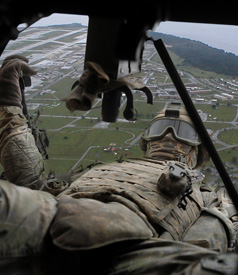Usually, when someone refers to a place as a “US colony,” they are making an analogy, suggesting that US influence somewhere is so strong, and the indigenous residents of the place have so little effective say over key decisions, that it’s as if the place were a formal US colony.
But, remarkably, and perhaps predictably, for a country whose leaders, editorialists and pundits constantly pontificate about how we are an indispensable force for freedom in the world, we rarely discuss the fact that there are places in the world that are actual US colonies. Still less do we consider whether we are complying with our international obligations to respect the right of self-determination for colonized peoples, and if we are not, what we could do to change that.
A small corrective is being offered as part of Asian Pacific Heritage Month byPBS, which is webcasting Vanessa Warheit’s documentary, “The Insular Empire: America in the Mariana Islands” until this Sunday, June 20.
The Mariana Islands comprise two political entities, the territory of Guam and the Commonwealth of the Northern Mariana Islands. Guam was ceded to the US by Spain in 1898 after Spain’s defeat in the Spanish-American war, while the Northern Mariana Islands were conquered by the US from Japan in World War II. As political entities, the two have several features in common: while they are ruled by Washington, and their residents are US citizens, many of whom serve in the US military, they have no vote in presidential elections, nor do they have a representative in Congress who can vote on the passage of legislation.
In other words: they are US colonies.
Guam, in particular, is facing a major decision about its destiny, a decision made in Washington about which its indigenous population has not yet had any effective say. The United States is currently planning to relocate 8,000 Marines and 9,000 dependents to Guam by 2014. With an expected influx of foreign workers recruited for military construction projects, Guam’s population is expected to increase by some 80,000 people by 2014, a 45 percent increase from its current estimated population of 180,000.
More than a quarter of the island is already owned by the US military, The Washington Post noted in March, while a quarter of the island’s population lives below the US poverty level.
As The Post noted, Guam was not consulted in the decision to move 8,000 Marines to the island and has no legal means to block it. Yet, an Environmental Protection Agency analysis said the US military buildup could trigger island-wide water shortages.
The possibility that Guam’s indigenous residents may suffer irreparable harm from this planned military buildup without ever having had any effective say about it, heightens the responsibility of Americans who do have voting representation in Washington to know something about the military buildup and its historical background. Thanks to PBS, until Sunday, we have the opportunity to catch up a little on the history they didn’t teach us in school.
Join us in defending the truth before it’s too late
The future of independent journalism is uncertain, and the consequences of losing it are too grave to ignore. To ensure Truthout remains safe, strong, and free, we need to raise $34,000 in the next 72 hours. Every dollar raised goes directly toward the costs of producing news you can trust.
Please give what you can — because by supporting us with a tax-deductible donation, you’re not just preserving a source of news, you’re helping to safeguard what’s left of our democracy.
